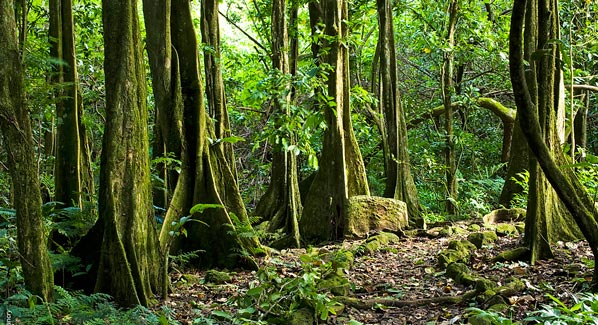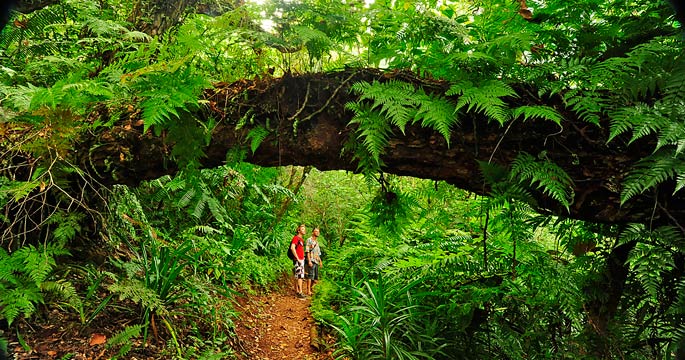Tropical trails that lead to lush valleys, waterfalls and scenic mountain summits
Truth is, no one comes to Tahiti just to hike. They come for white sand beaches, sparkling lagoons and kaleidoscopic reefs. But there are still good reasons to pack the walking shoes along with the flip-flops, and those who take to the trails are rewarded with lush landscapes and magnificent views. Some routes are easy, well maintained and marked. Others not so much. Fortunately, guides are available at reasonable rates, and many are fonts of wisdom on island flora, fauna and history. Here are some of our favorite hikes on the three major islands of the Tahiti group.

A grove of banyan trees provides shade on a footpath through Moorea’s Opunohu Valley. This popular hiking route leads to an elevated overlook known as Three Coconut Trees Pass. Photo: Xavier Lancry/Tahiti Tourisme
Tahiti
One of the best ways to discover Tahiti’s interior beauty is on the Fautaua Valley trail. The walk starts at Papeete Town Hall, and follows a marked route along a jungle stream framed by lush groves where mango, guava, and banana trees grow wild. Three miles later, you will reach the base of 450- foot-high Fautaua Falls. Stop and enjoy or continue on for a steep half-hour climb to the top of the cascade.
More adventurous hikers can hire a guide for a trip through the Hitiaa Lava Tubes. A two-mile walk leads to a series of giant tunnels formed by cooling lava. A river runs through these passages, which are up to 900 feet long. Exploring the tubes will require some wading and scrambles down small waterfalls and across boulders, so plan on getting wet. Tahiti’s most challenging hike is an ascent of the island’s second highest peak, 6,88-foot Mt. Aorai. This demanding 12-mile round trip is an all day adventure that passes by some steep cliffs, and is best done with a guide, and during the dry season.
Bora Bora
A must-do hike on the island of Bora Bora is a visit to the Valley of the Kings. An easy three-hour walk into a lush interior basis that holds the recently- discovered remains of ancient Polynesian homes and temples, and a huge banyan tree that is a living mausoleum. Along the way, guides share stories of island geology, ancestral plants, medicine, Polynesian legends and sacred trees. They may also share wild island fruits and coconuts plucked straight from the trees.
Other walks in the valley include the Ancestors Road and the Track of the Past, which delve deeper into the historic secrets of the valley. More ambitious hikers can make the uphill trek to the sacred Cave of Anau, or make a six-hour round trip climb to the 2,100-foot summit of Mt. Pahia for 360-degree views of the island.
Moorea
For an easy and rewarding walk, follow a trail from the village of Afareaitu through a green landscape of mango trees, past coffee plants, wild orchids and vanilla. An easy half-hour ramble brings you to a pair of waterfalls that tumble 200 feet into pools that are ideal for a cooling swim. Moorea’s most popular hike is the loop through the Opunohu Valley, which follows a well- maintained trail as it climbs some 500 feet to the high point known as Three Coconut Trees Pass. From this elevated saddle hikers can enjoy open vistas of the north and south coasts of the island, plus up-close views of Mt. Mouaroa and Mt. Tohiea.
A slightly more strenuous route is the two-hour walk from the village of Vaiare to Pao Pao on Cook’s Bay. The route ascends to a ridge that delivers grand views of 7,300-foot Mt. Orohena, as well as the whole interior of Moorea. The island’s most challenging trek is a climb to the summit of Mt. Rotui, which holds a special place in Polynesian mythology, and provides a glimpse into the interior of an extinct volcanic crater.





